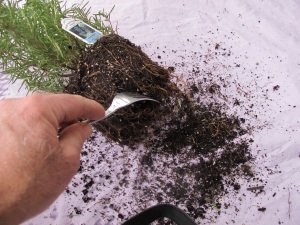Spring Activities Indoors
I am NOT going to kill my rosemary plant this March. Really. It is so easy to do, and most of us who grow rosemary have done it at least once. We get a perfectly nice rosemary plant through the winter, and then in March we kill it. Why? Because the sun is stronger, hotter, and because our plants are waking up after a winter’s semi-dormancy and starting to grow. All of that means our plants need more water.
I called Sarah Milek of Cider Hill Gardens in Windsor, Vermont, who is an expert grower of herbs (and all plants, really). She confirmed that rosemary needs more water now. And she said March is also a good time to re-pot rosemary. Your rosemary wants to put on new growth now, both roots and leaves. But if the roots are tangled and snarled, or if the pot is full of roots, the plant really cannot grow well.
I took my rosemary plant, which is growing in a 5 inch diameter pot, and knocked it out of the pot: I turned it upside down over the kitchen sink, and gave it a sharp rap on the bottom of the pot with the heel of my hand. Then, with a gentle tug, I slid it out of the pot. I was looking for dead, brown roots – signs of overwatering and decay that need to be removed – but saw none. The roots were light-colored and in good health. They did not break when tugged on.
Rather than using a bigger pot, I decided to cut back the roots a bit to stimulate new growth, and to allow me to add fresh potting mix to the pot. Sarah Milek suggests using a kitchen fork to open up the roots and loosen the potting soil attached to the roots. Then it’s easy to cut back the roots with scissors. But, Sarah warned, don’t be overly drastic. A gentle haircut is all that is needed.
I added three quarters of an inch of fresh potting soil at the bottom of the pot and placed my rosemary in it. Then I poured in fresh potting soil around the edges and tamped it down.
Sarah reminded me that rosemary likes to grow with some humidity in the air – which is tough for a household like mine that uses a woodstove every day. She suggested I place some gravel in a dish or pan, and then water the stones before placing the potted rosemary on top of the stones. I’ve also heard that spraying the leaves with a fine mist of water makes rosemary very happy – though my tough love approach to houseplants generally precludes that.
Temperature is important for success with rosemary, and houseplants in general. Most plants do not want a very warm spot, so keep them away from radiators and wood stoves. In this season a south or west-facing window can get pretty hot in the afternoon, so an eastern exposure is better.
I asked Sarah Milek what other houseplants needed attention at this time of year. She mentioned geraniums (Pelergonium spp.). Most of us grow geraniums for their big red, pink or white blossoms that shine on seemingly forever. But in the course of a winter indoors, many have gotten leggy – with long stems, that is. The solution? Cut them back now. I generally cut back to a node, and then take the cutting and root it in water.
Sarah says rooting geraniums is better done in moist perlite. Perlite, the fluffy white stuff in potting mix, can be purchased in bags at the garden center. It is not Styrofoam, which it resembles, but a heat-expanded mineral made like popcorn in an industrial oven at very high temperatures. It holds moisture well but also releases it to plants when needed. It has a neutral pH. Sarah says you should tent your geranium cuttings – put them in a clear plastic bag so that they do not lose moisture.
Perlite is very light weight, so larger cuttings can easily tip over if using a lightweight plastic pot. A heavier ceramic pot would prevent that, or you could place stones or sand in the bottom of a plastic pot. Perlite provides no nutrition so once they are rooted, you need to give them a light dose of fertilizer weekly. Fish or seaweed fertilizer diluted to one quarter the regular dose is fine.
Other indoor activities for the cabin-fever-feeling gardener include starting some vegetables of flowers from seed. I have started onions, leeks and artichokes – all plants that need a long time from seeding to maturity. In mid-March I will plant hot pepper seeds, and then tomatoes, broccoli, kale and other veggies in early to mid-April.
If you have never grown artichokes, you might want to. There are several kinds of seeds available, including Green Globe, Purple of Romagna, Opera and ‘Imperial Star’. In past years when growing Green Globe artichokes, I followed the dictum that you must move them into a 50 degree growing space for 2 weeks at the 3 or 4 leaf stage to fool them into thinking they had lived through a winter. That meant setting up lights in my cold basement. But Imperial Star and Opera (a purple one I have not yet tried) are both grown for annual production, and do not need that cold period. Much easier. My artichoke plants produce 3-7 small chokes each year, but are also very pretty plants suitable for a flower garden.
Spring is just around the corner – and my rosemary plant knows it. It’ll be happier since this year I’m being attentive to its needs.
Henry is a UNH Master Gardener and the author of 4 gardening books. His book The New Hampshire Gardener’s Companion will be out in an expanded second edition later this month. His website is www.Gardening-Guy.com.




